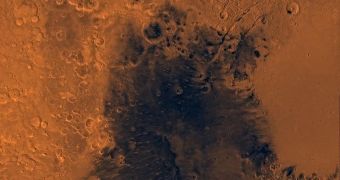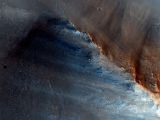Most of you know that Uranus, Neptune and Jupiter all have dark spots, features that are most likely created by various types of interactions in the gas giants' atmosphere. But not many are aware of the fact that Mars also features such a formation, which was first identified on October 13, 1659. Behind the telescope that detected the first accurate image of Mars was the famous Dutch astronomer Christiaan Huygens, the same after whom the Titan Huygens lander was named. In his drawings of the Red Planet, the astronomer also included a dark spot.
In fact, the feature was so pronounced that he used it to calculate the rotation time of the planet. The scientist then asserted that Mars revolved around its own axis once every 24 hours. This estimate is not far from the truth. The most advanced modern methods show that the Red Planet indeed completes one rotation in 24 hours and 38 minutes, taking about half an hour longer than the Earth to do so. Huygens' description of the planet was so good that renowned astronomer Percival Lowell, the founder of the Lowell Observatory, said it was “the first drawing of Mars worthy of the name ever made by man.”
More recent observations determined that the dark spot in the Dutch astronomer's notes was in fact a feature now known as Syrtis Major. It lies directly on the boundary between the northern lowlands and southern highlands of the planet, and close investigations have determined that it is in fact a low-lying shield volcano. These formations form when erupting lava is very fluid, and travels great distances over little-inclined slopes. They have a flat and broad profile, and their slopes are very shallow. Data from the Mars Global Surveyor (MGS) orbiter was used to make this classification.
One of the main reasons why the area appears darker than the rest of the planet is the fact that little dust exists there. Everywhere else on Mars, the reddish hue that gives the planet its name is omnipresent. Another reason is the fact that the rocks making up the feature are basaltic, and therefore black in color. They are believed to have exited the mantle when the planet was still very young, and also geologically active. Since then, the Red Planet's core stopped, and so did all tectonic processes related to its spin.
In a new Mars Reconnaissance Orbiter (MRO) image, taken with the High Resolution Imaging Science Experiment (HiRISE) camera, a fragment of Syrtis Major is shown in great detail. In this particular frame (second image), a crater about 50 kilometers wide exposes the layers of the volcano up to a significant depth. This allowed researchers to look deep into the various types of materials making up the inside of the volcano. Thus far, lava flows, debris from nearby impact craters, and deposits of dust or sand have been identified, Space Fellowship reports.

 14 DAY TRIAL //
14 DAY TRIAL // 
